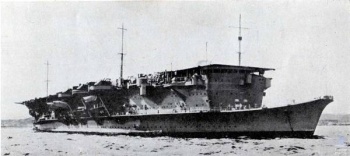Post by Diarist on Mar 21, 2017 14:13:18 GMT 1
Ryūjō (Japanese: 龍驤 "Prancing Dragon") was a light aircraft carrier built for the Imperial Japanese Navy (IJN) during the early 1930s. Small and lightly built in an attempt to exploit a loophole in the Washington Naval Treaty of 1922, she proved to be top-heavy and only marginally stable and was back in the shipyard for modifications to address those issues within a year of completion.
Design
Ryūjō was planned as a light carrier of around 8,000 metric tons (7,900 long tons) standard displacement to exploit a loophole in the Washington Naval Treaty of 1922 that carriers under 10,000 long tons (10,000 t) standard displacement were not regarded as "aircraft carriers". While Ryūjō was under construction, Article Three of the London Naval Treaty of 1930 closed the above-mentioned loophole; consequently, Ryūjō was the only light aircraft carrier of her type to be completed by Japan.
Ryūjō had a length of 179.9 meters (590 ft 3 in) overall. She had a beam of 20.32 meters (66 ft 8 in) and a draft of 5.56 meters (18 ft 3 in). She displaced 8,000 metric tons (7,900 long tons) at standard load and 10,150 metric tons (9,990 long tons) at normal load. Her crew consisted of 600 officers and enlisted men.
To keep Ryūjō's weight to 8,000 metric tons, her hull was lightly built and no armour could be provided, although some protective plating was added abreast the machinery spaces and magazines. She was also designed with only a single hangar, which would have left her with an extremely low profile (there being just 4.6 meters (15 ft 1 in) of freeboard amidships and 3.0 meters (9 ft 10 in) aft). Between the time the carrier was laid down in 1929 and launched in 1931, however, the Navy doubled her aircraft stowage requirement to 48 in order to give her a more capable air group. This necessitated the addition of a second hangar atop the first, raising freeboard to 14.9 meters (48 ft 11 in). Coupled with the ship's narrow beam, the consequent top-heaviness made her minimally stable in rough seas, despite the fitting of Sperry active stabilizers. This was a common flaw amongst many treaty-circumventing Japanese warships of her generation.
The Tomozuru Incident of 12 March 1934, in which a top-heavy torpedo boat capsized in heavy weather, caused the IJN to investigate the stability of all their ships, resulting in a number of design changes to improve stability and increase hull strength. Ryūjō, already known to be only marginally stable, was promptly docked at the Kure Naval Arsenal for modifications that strengthened her keel and added ballast and shallow torpedo bulges to improve her stability. Her funnels were moved higher up the side of her hull and curved downward to keep the deck clear of smoke.
Shortly afterward, Ryūjō was one of many Japanese warships caught in a typhoon on 25 September 1935 while on manoeuvers during the "Fourth Fleet Incident." The ship's bridge, flight deck and superstructure were damaged and her hangar was flooded. Her forecastle was raised one deck and her bow was remodelled with more flare to make her less wet forward. After these modifications, her beam and draft increased to 20.78 meters (68 ft 2 in) and 7.08 meters (23 ft 3 in) respectively. Her displacement also increased to 10,600 metric tons (10,400 long tons) at standard load and 12,732 metric tons (12,531 long tons) at normal load. Her crew also grew to 924 officers and enlisted men.
Construction and service
Following the Japanese ship-naming conventions for aircraft carriers, Ryūjō was named "Dragon Horse". The ship was laid down at the Mitsubishi's Yokohama shipyard on 26 November 1929. She was launched on 2 April 1931, towed to Yokosuka Naval Arsenal on 25 April for fitting out, and commissioned on 9 May 1933 with Captain Toshio Matsunaga in command. While training in mid-1933, her initial air group consisted of nine Mitsubishi B1M2 (Type 13) torpedo bombers, plus three spares, and three A1N1 (Type 3) fighters, plus two spares. Matsunaga was relieved by Captain Torao Kuwabara on 20 October. After the Tomozuru Incident, the ship was reconstructed from 26 May to 20 August 1934.
Captain Ichiro Ono assumed command on 15 November 1934 and Ryūjō became the flagship of Rear Admiral Hideho Wada's First Carrier Division. The following month the ship was chosen to evaluate dive-bombing tactics using six Nakajima E4N2-C Type 90 reconnaissance aircraft, six Yokosuka B3Y1 Type 92 torpedo bombers, and a dozen A2N1 Type 90 fighters. The reconnaissance aircraft proved to be unsuitable after several months' testing. Ryūjō participated in the Combined Fleet Manoeuvers of 1935 where she was attached to the IJN Fourth Fleet. The fleet was caught in a typhoon on 25 September and the ship was moderately damaged. Ryūjō arrived at Kure on 11 October 1935 for repairs, modifications, and a refit which will last until mid-1936.
Source: Wikipedia - " rel="nofollow" target="_blank">en.wikipedia.org/wiki/Japanese_aircraft_carrier_Ry%C5%ABj%C5%

